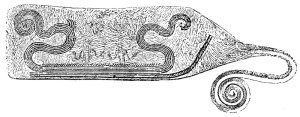Meaning of Name: Hengest and Horsa’s names mean ‘Stallion’ and ‘Horse’ respectively.
Pronunciation: /ˈheŋɡest/ – /ˈhendʒest/ and /ˈhorsɑ/ The first ‘e’ in Hengest is pronounced as the ‘e’ in ‘then’ and the second ‘e’ is pronounced as the ‘e’ in ‘jest’. The ‘o’ in Horsa is pronounced as the ‘o’ in the word, ‘force’ and the ‘a’ as in ‘sofa’. There is some debate as to the pronunciation of the ‘g’ in Hengest. Mallory states the correct pronunciation should be as the ‘dg’ in the word ‘edge’ and gives the phonetic transliteration as ‘Hendʒest.’
Other names/ Spelling variations: Hengist, Hors, possibly the Alcis
Function: Although Hengest and Horsa appear as mortal warriors in Anglo-Saxon foundation stories, there are scholars, such as Simek and Mallory, who have suggested ties between Them and similar divine horse twins present in Indo-European religions. Given that both Hengest and Horsa’s names essentially mean “horse”, a role associated with horses is indeed likely. This equine connection is further established through a possible connection to the earlier Alcis, mentioned in Germania, where Tacitus describes them as “dieties [that] are said to be the counterpart of our Castor and Pollux.” In Roman iconography, the Disocuri are often depicted on horseback or walking alongside horses.
Nordic Bronze Age carvings and metalwork depicting twins may be representative of an earlier twin-cult, and be of some use in reconstructing Hengest and Horsa as solar deities. In these examples, two horses are frequently paired with a solar-wheel, as if to suggest they are driving the sun on its natural progression through the heavens. According to Gelling, the symbols most frequently associated with the Nordic Bronze Age solar cult were the ship, ritual axes, horses, footprints and twin figures, many of which frequently appear together[1].
A Danish razor from Voel displays a similar solar ship, manned by two prominent figures, who are depicted with lines radiating out of their heads[2]. While it’s uncertain whether these lines are intended as allusions to sun imagery, it is possible, given that they are depicted alongside a probable sun-vehicle. This is but one example of two male figures standing together aboard a solar ship. While the ship-as-vehicle image is more frequent in occurrence, the image of horses or stags dragging the sun is also widespread and suggests an interchangeability of symbolism. The Trundholm Sun Chariot is a prime representation of this motif and may have been considered the dominant form of solar locomotion prior to it being supplanted by the solar ship some time later, possibly due to Greek influence from the South[3]. If the symbol of the horses and the symbol of the twins were indeed interchangeable, this may suggest these Bronze Age figures were associated with the horse and by virtue of that fact, associated with the sun cult.
Iconography: There are those who theorize a connection between Hengest and Horsa and the horse-head gables found on Low-German houses. Anything representing duality, twinhood, or horses. The sun-wheel, solar barge and other solar symbols might also be appropriate. The double-sided axe may also serve as an icon of the Gods, due to its connections to the Bronze Age solar cult and its occurence among the twin figures in the Grevensvænge hoard.
Attested Sources: In Bede’s Historia Ecclesiastica Gentis Anglorum, Hengest and are Horsa are listed as the first chieftains among the Angles, Saxons and Jutes in England. The entry for the year 449 of the Anglo-Saxon Chronicle records Hengest and Horsa as being invited to Britain by Vortigern and defeating an army of Picts at his request. The entry for the year 455 records the battle of Aylesford, where Horsa is purportedly slain. In 473 it is recorded that Hengest and Esc fought the native Britons, who were conquered and sent fleeing “like fire”. Historia Brittonum also records the story of Hengest and Horsa and their first dealings with Vortigern and the Britons. Geoffrey of Monmouth’s Historia Regum Britanniae presents a fanciful recreation of Hengest and Horsa’s first dealings in England. Hengest is mentioned briefly in Snorri’s prologue of the Prose Edda.
Interpretatio Romana: The Dioscuri (Castor and Pollux), possibly Apollo via Greece.
Contemporary Bīnaman: Sunnbǣras (Sun-Bringers), Bardamenn (Bargemen), Crætwīsan (Charioteers), Lēodfruman (founders), Ēorodmenn (Horsemen)
[1] Gelling, Peter & Ellis Davidson, Hilda. The Chariot of the Sun: Aldine House, 1969
[2]

[3] Gelling, Peter & Ellis Davidson, Hilda. The Chariot of the Sun: Aldine House, 1969